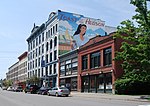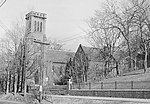Kate Mullany House

The Kate Mullany House was the home of Kate Mullany (1845–1906), an early female labor leader who started the all-women Collar Laundry Union in Troy, New York in February 1864. It was one of the first women's unions that lasted longer than the resolution of a specific issue. It is located at 350 8th Street in Troy, just off NY 7 one empty lot east of the Collar City Bridge. The house was declared a National Historic Landmark in 1998. It is now a National Historic Site. The site also includes Mullany's grave. The New York State Senate honored the house and its most famous resident for Women's History Month in March 2007. The house is also on the New York Women's Heritage Trail.
Excerpt from the Wikipedia article Kate Mullany House (License: CC BY-SA 3.0, Authors, Images).Kate Mullany House
8th Street, City of Troy
Geographical coordinates (GPS) Address Nearby Places Show on map
Geographical coordinates (GPS)
| Latitude | Longitude |
|---|---|
| N 42.7399 ° | E -73.681802777778 ° |
Address
8th Street 345
12180 City of Troy
New York, United States
Open on Google Maps







